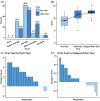Bridging the Gap: Evaluation of an Electrocardiogram Curriculum for Advanced Practice Clinicians
- PMID: 38596911
- PMCID: PMC11000549
- DOI: 10.5811/westjem.18085
Bridging the Gap: Evaluation of an Electrocardiogram Curriculum for Advanced Practice Clinicians
Abstract
Background: Training programs for advanced practice providers (APP) often have significant variability in their curriculum, including electrocardiogram (ECG) education. Despite limitations in formal ECG training, APPs in the emergency department (ED) may be the first practitioner to interpret an ECG. Foundations of Emergency Medicine (FoEM) offers free, open-access curricula that are widely used for resident education. We sought to improve APP ECG interpretation skills by implementing the FoEM ECG I course.
Methods: This was a single-site, pre- and post-intervention study of 23 APPs at our high-acuity, urban ED. In the fall of 2020, APP learners enrolled in a FoEM ECG I course led by faculty and senior resident instructors. The course consisted of six virtual, small-group, active-learning ECG workshops. Participants completed a 15-question multiple-choice test before, immediately after, and six months post-intervention to quantify knowledge acquisition. Additionally, a pre- and post-intervention knowledge, attitudes, and practices survey was administered on ECG interpretation skills and to evaluate the course. We evaluated change in ECG knowledge scores using a Wilcoxon signed-rank test. Changes in self-assessed knowledge were evaluated using an ordinal logistic mixed-effects regression.
Results: A total of 23 APPs enrolled in the course. Knowledge assessments showed APPs improved from the pre-test (median 9/15, interquartile range [IQR] 7-11) to the post-test (median 12/15, IQR 10-13; P = 0.001). Test scores did not significantly change from the post-test to the delayed post-test (median 12/15, IQR 12-13; P = 0.30). Respondents' subjective rating of their skill did not significantly change (P = 0.06). Respondents reported no change in their likelihood of approaching an attending when uncertain of the correct interpretation of an ECG (P = 0.16). Overall, 91% were satisfied with the course and 96% agreed that the course difficulty was appropriate.
Conclusion: The FoEM ECG course provided a standardized curriculum that improved APP knowledge for interpreting ECGs. Despite this, the course did not alter APPs' willingness to approach physicians for guidance with interpretation of abnormal ECGs. These findings may inform expansion of this concept for other programs who desire formalized APP ECG education.
Conflict of interest statement
Figures

References
-
- Menchine MD, Wiechmann W, Rudkin S. Trends in midlevel provider utilization in emergency departments from 1997 to 2006. Acad Emerg Med. Oct 2009;16(10):963–9. - PubMed
-
- Statistical Profile of Certified PAs Annual Report . 2021: National Commission on Certification of Physician Assistants website. 2022. Available at: https://www.nccpa.net/wp-content/uploads/2022/08/2021StatProfileofCertif.... Accessed April 12, 2023.
-
- NP Fact Sheet . American Academy of Nurse Practitioners website. 2022. Available at: https://www.aanp.org/about/all-about-nps/np-fact-sheet. Accessed April 12, 2023.
MeSH terms
LinkOut - more resources
Full Text Sources
Miscellaneous
